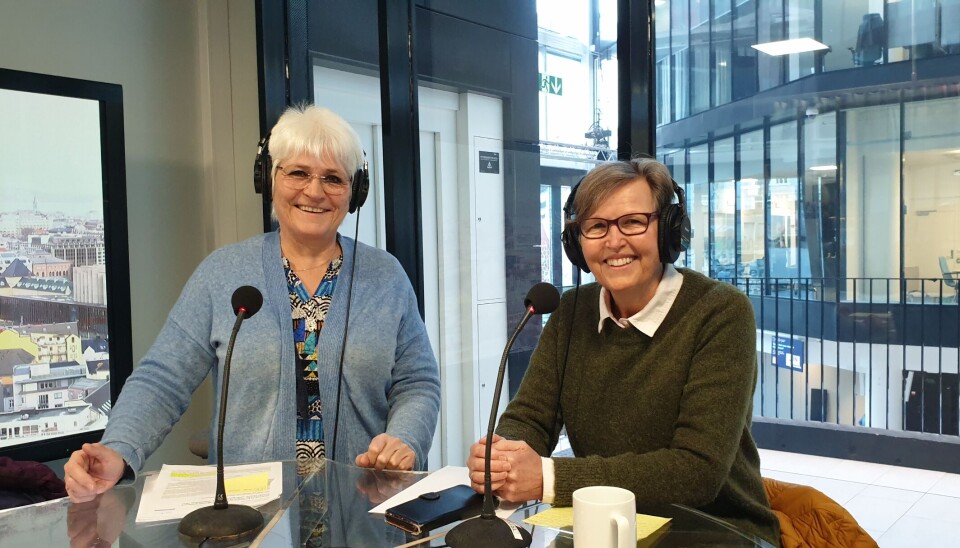
What gives sick people hope?
When patients were asked where they find hope and strength, their answers surprised researchers.
Where do you find hope and strength? Where do you go when you need help?
These were among the questions that were asked of nearly 400 patients aged 18 to 90 years.
They had many different ailments, ranging from broken bones to cancer.
Some were still being treated. Others had recovered from their disease.
The questions were posed by nursing students who were asked to reflect on the conversation in a log after the discussion had taken place.
Difficult to ask
These logs have been analysed by researchers Britt Moene Kuven and Tove Giske.
Both women now work at VID Specialized University in Oslo. This institution is values-based and has its roots in the Norwegian church. Kuven was working at the Western Norway University of Applied Sciences when the study was carried out.
Kuven said the nursing students found it difficult to ask these questions.
“They felt that the questions were private. They were outside of their comfort zone when they had what they felt was a very personal conversation. At the same time, the students felt that it was a relief for the patient to put their feelings into words,” she said.
Someone to share thoughts with
Hope is important in helping people endure suffering and can be crucial for how we cope with illness, the researchers said.
Other international studies have also looked at the meaning of hope in patients from different countries and with a variety of medical diagnoses.
The vast majority of the nearly 400 patients in this study said they found hope in family and friends.
They didn’t need a large number of people to rely on, just one or two were enough. But the respondents said it was important to share their thoughts with someone they trusted — and who could listen.
“This is not so surprising. But it’s an important reminder for the health service,” Kuven said.
“We may not have been aware of how important family and friends are in helping maintain hope in some patients. For example, Norwegian hospitals have very limited visiting hours,” she said.
Found hope in something ‘up there’
What was even more surprising for the researchers was that very many of those who said they found hope in their loved ones also said that they found hope in something spiritual. Something intangible outside of yourself.
Many described this as a hope that there was something more, something outside of us, that could come to our rescue when we were having a hard time.
“Even though many were not believers, they prayed as if they were, ‘just in case’. They had the hope that someone out there would hear them— a force in the universe that could help them,” she said.
The researchers were interested by this finding.
“Surveys in Norway show that not many people are interested in religion on a daily basis. Fewer people go to church. But when we get sick, there is still a hope that there is something out there that can help you,” the researchers said.
In Norway’s busy and technologically laden hospitals, it can be easy to forget the soothing function that having hope and belief in something outside oneself can have, Kuven said.
“We as nurses here in the Nordics are probably not so used to talking to patients about topics like this. We feel these topics are very private,” she said.

Many found hope in nature
Many patients found hope in nature.
They forgot their own problems when they were outside. The patients used words like calm, peace and comfort to describe how they found hope outdoors.
Some participants found it difficult to get outside due to health problems. They used nature films to find rest and strength to move on and forget the pain.
"I dream that I am back in nature. This gives me hope for the future," one patient said.
“We nurses may have been too unaware of the soothing power of nature in our daily work with patients. I have taught nurses for 25 years without us having any particular focus on this in the curriculum,” Kuven said.
As early as the end of the 19th century, Florence Nightingale was aware of the healing function of nature. Kuven wondered if perhaps it was time to revive some of her thoughts about nature.
“I think it's coming. A lot of research is gradually suggesting that nature is important for health, including mental health. We should take this more seriously,” Kuven said.
Some only found hope in themselves
Those who found hope in friends and family, nature or the universe often found hope in several of these sources at the same time. They had confidence that something or someone could help them.
Hope gave them strength and helped them endure the suffering that disease or failing health had inflicted on them.
But a small group had lost confidence in finding hope outside themselves. They found no hope anywhere but in themselves.
“This largely resulted when patients had been let down by other people. As a result, they only trusted themselves,” Kuven said.
- READ When bathing was medicine: What can we learn from doctors who promoted sea bathing back in the day?
The effects of mental health and substance abuse problems
Knut Tore Sælør has studied people who have mental health and substance abuse problems. He works as an associate professor at the University of South-East Norway.
Sælør interviewed nine people for his doctorate who had experienced concomitant mental health and substance abuse problems. He also studied eight municipal employees who worked with them.
He wanted to look at hope in this group because he himself has found that the system that offers help to these individuals can contribute to hopelessness, both for users and employees.
But there is enough hope in and for this group as well, he said.
“Their version of hope was about daring to believe that something better was possible,” he said.
“They might find hope in small and everyday achievements, such as having enough food in the fridge or getting help to wash and clean. It might also be about having a suitable place to live, work or something else meaningful to fill everyday life with,” he said.

Hope most often linked to others
Many people with these problems have experienced disappointing both themselves and others. Many times.
“But having someone around them who had faith in them and who they could trust was very important to them,” he said.
Hope is most often something that arises in relationships with others, he said.
“It largely concerns creating good living conditions and surroundings, such as having generous and inclusive communities", Sælør said.
Although it is important to have someone around you who believes in you, there is also something more that is needed to ignite hope in you, Sælør said.
“For people who participated in the study, it was also about deciding,” he said.
The people he interviewed were focused on how important their own efforts were in achieving change. They had to decide for themselves to do something about their situation.
This does not mean that Sælør thinks people are the sole creators of their own fortune.
“We are very dependent on other people. But this is also something where we are completely alone,” he said.
Hope where you least expect it
Hope appears where you least expect it, he said.
“That makes it difficult to give people a recipe for how to give people hope. It's much easier to take hope away from them,” he said.
He thinks people who have struggled with these problems have often encountered this issue. Their experience is that things don’t work out and that everything is just hopeless.
“But sometimes things can work out. I think we easily forget that,” he said.
Translated by Nancy Bazilchuk
Reference:
Britt Moene Kuven and Tove Giske: Hope that provides strength in illness– patients’ perspectives: Nursing students’ narratives after conversation with patients. Scandinavian Journal of Caring Sciences, 2022.
———
Read the Norwegian version of this article at forskning.no
































